Abstract
149 previously untreated patients with Parkinson's disease were recruited over a three year period and randomly allocated to either low dose levodopa-carbidopa (< or = 600/150 mg/day) or low dose bromocriptine (< or = 30 mg/day). A five year follow up is reported on the 126 patients who completed the dose titration and who have not developed features of atypical Parkinsonism. Levodopa-carbidopa in low dosage adequately controlled symptoms in most patients and delayed the appearance of dyskinesia and end of dose failure for about two years longer than conventional doses. Only a few patients could be managed for more than one year on low dose bromocriptine alone; these patients had mild disease and asymmetric signs. Patients randomised to bromocriptine did not develop dyskinesia or troublesome end of dose failure until levodopa-carbidopa was added. The prevalence of dyskinesia in this group was lower than in patients given levodopa-carbidopa alone. The prevalence of end of dose failure was similar in the two randomisation groups once levodopa was introduced.
Full text
PDF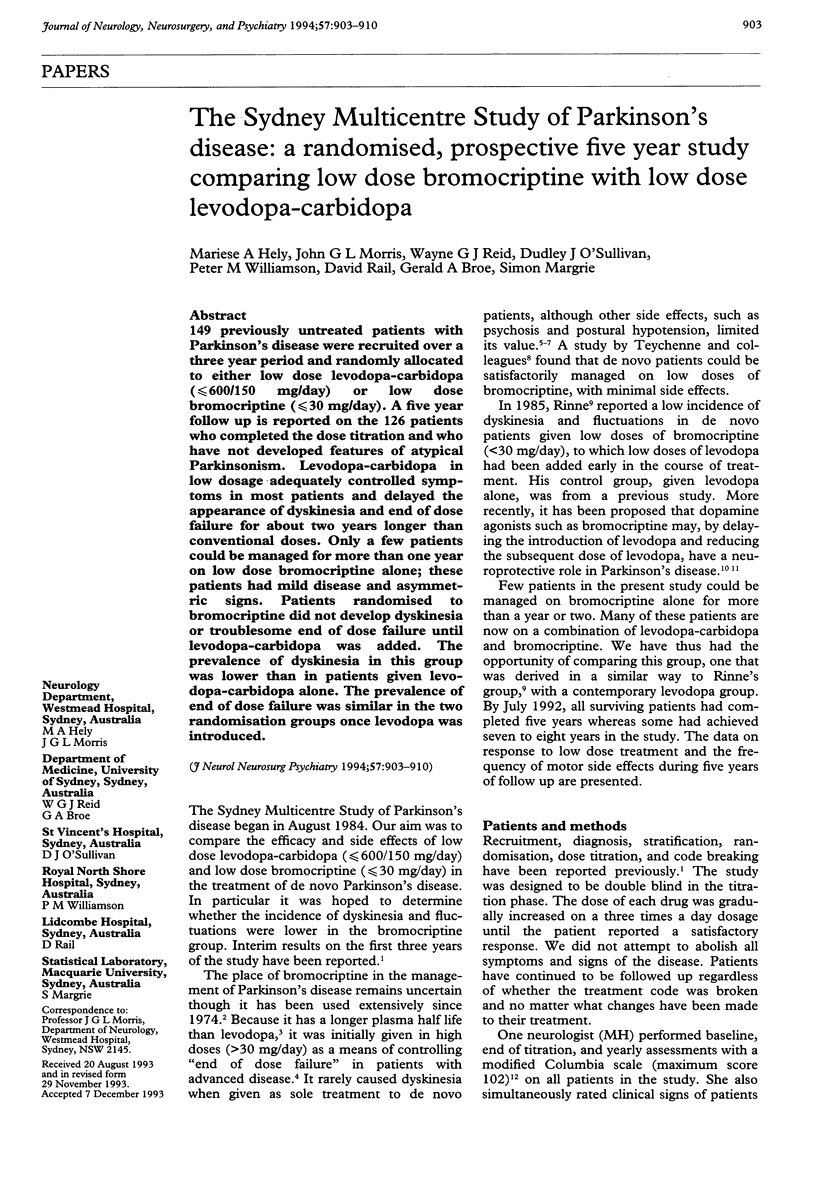
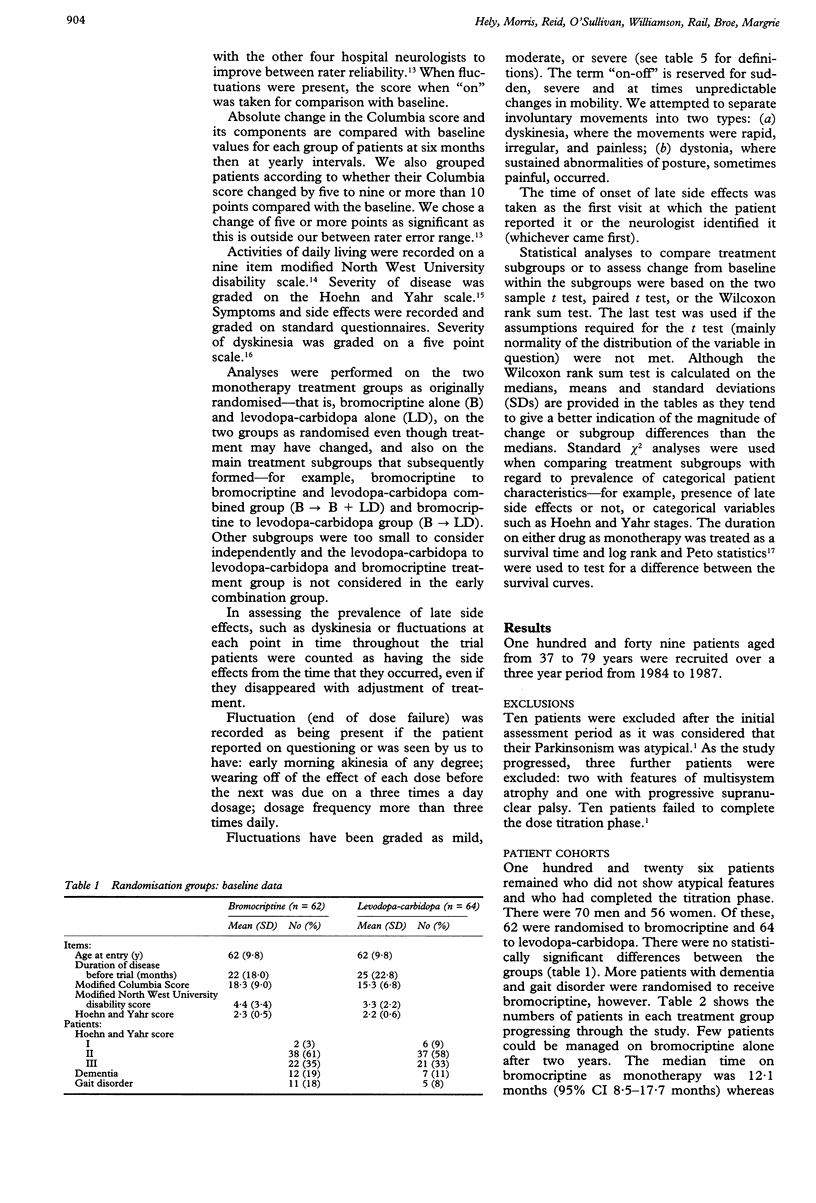
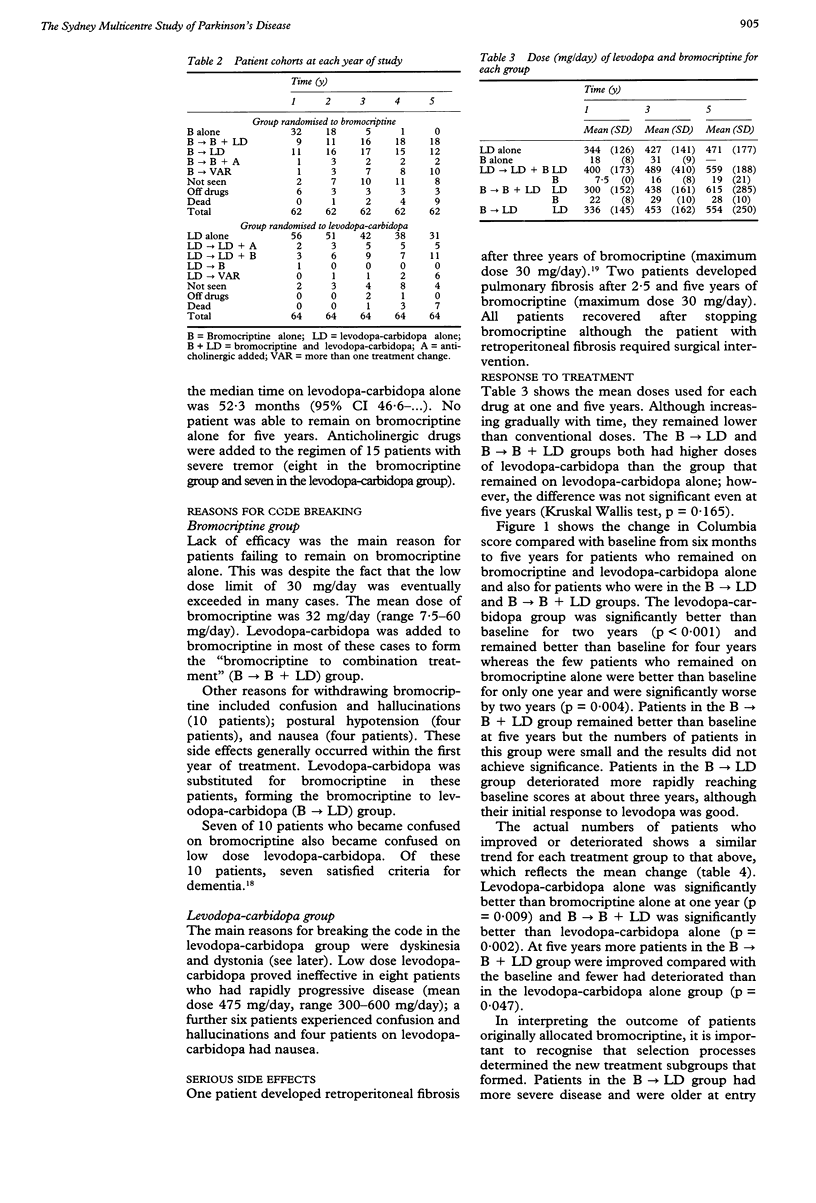
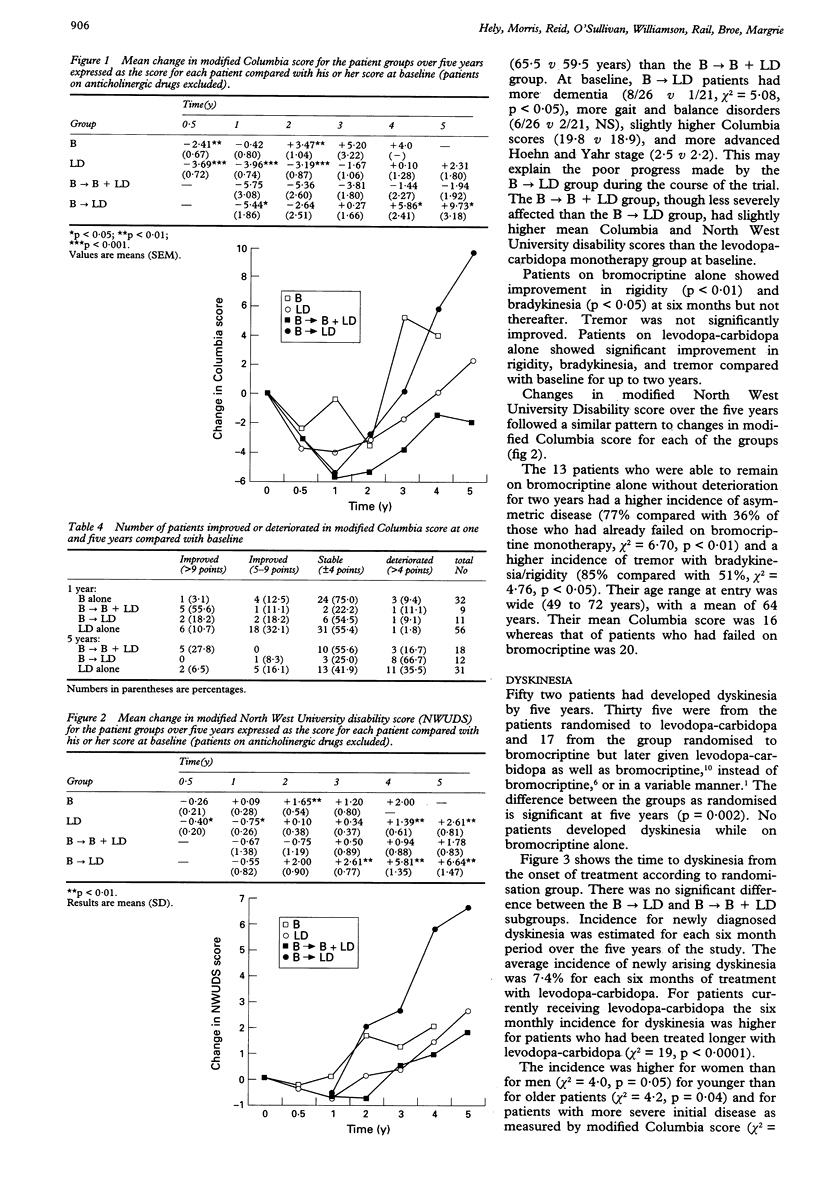
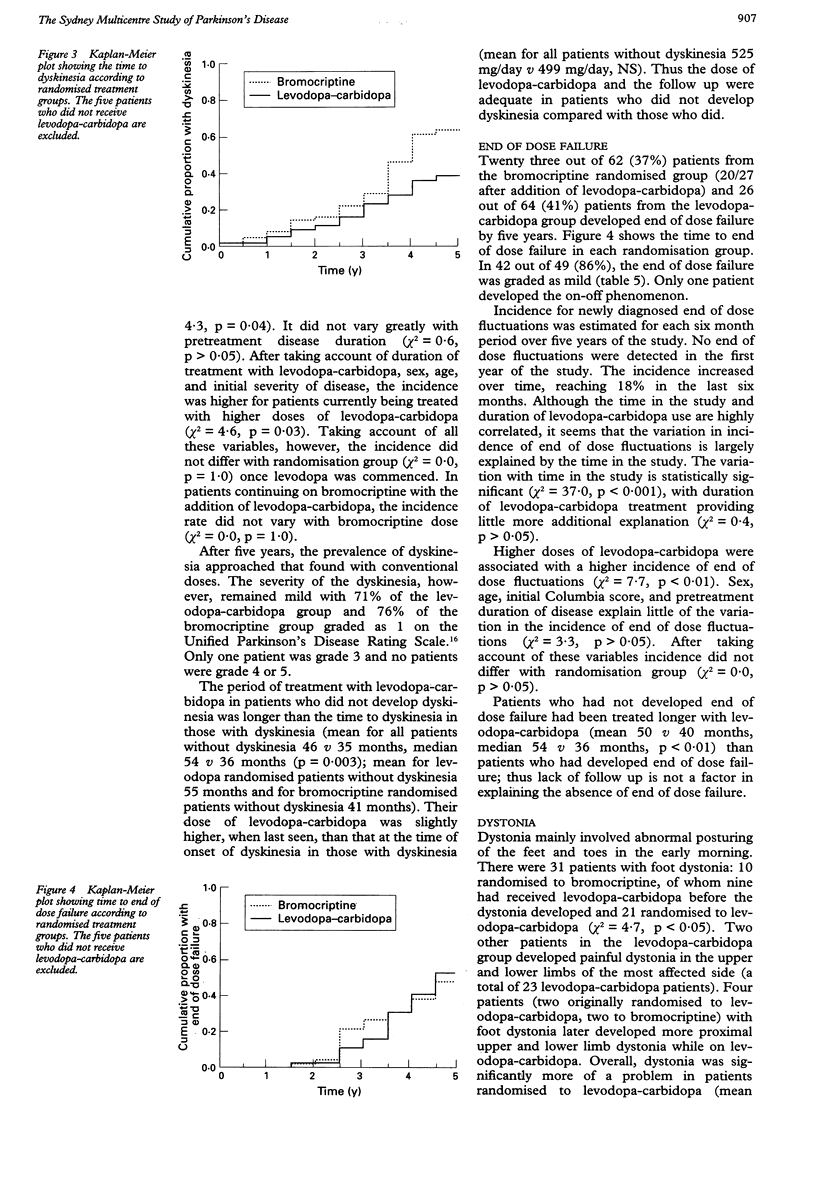
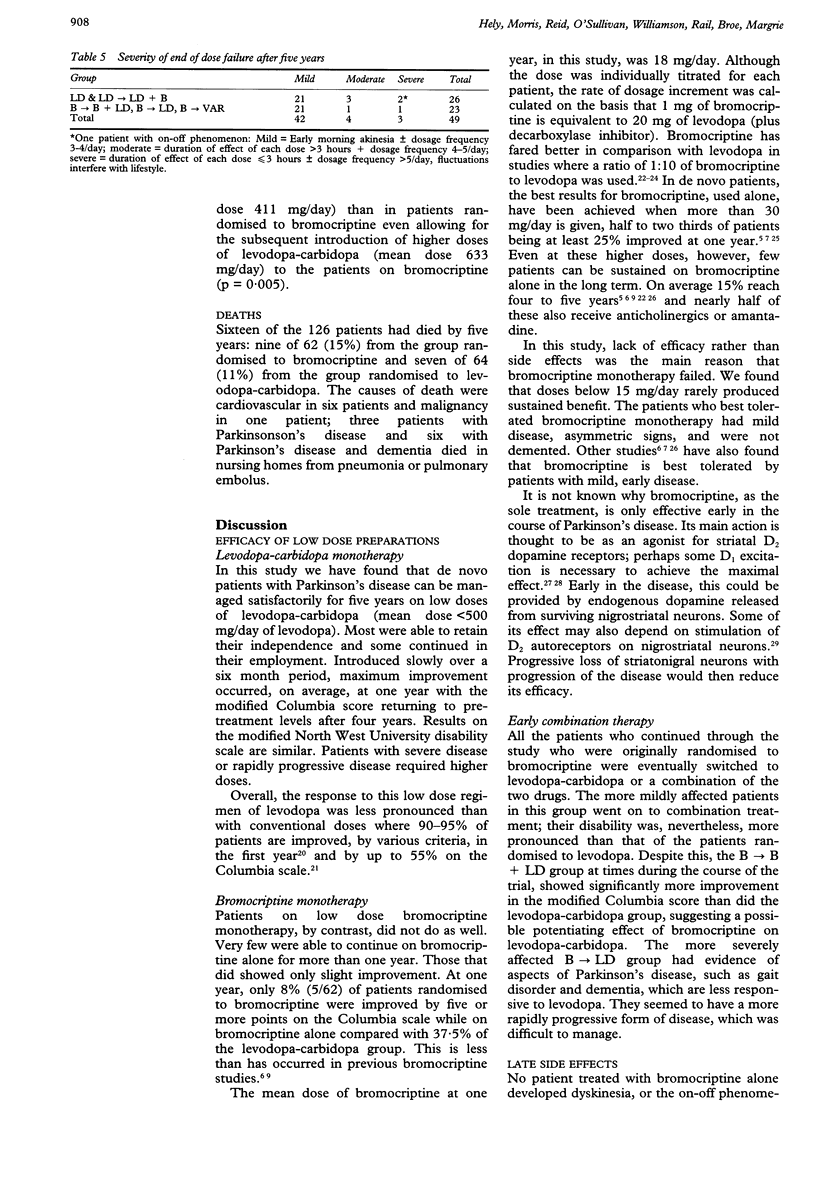
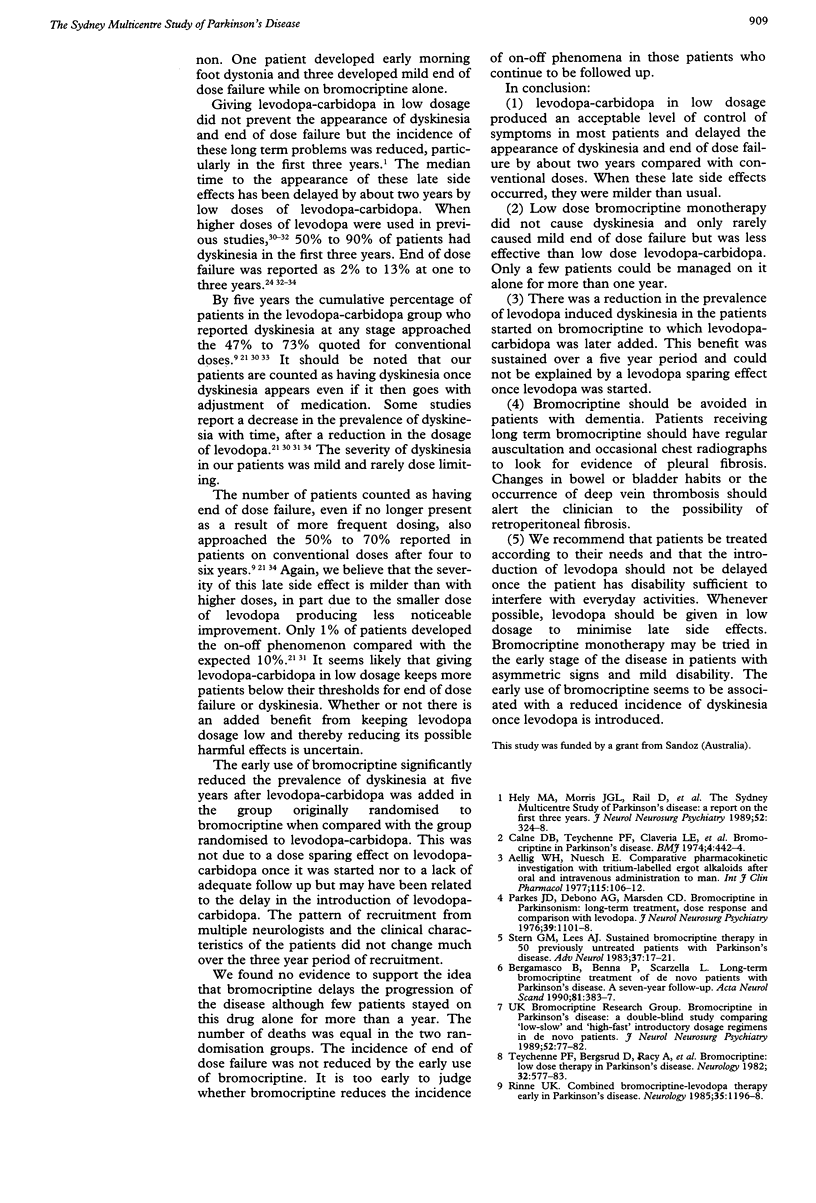
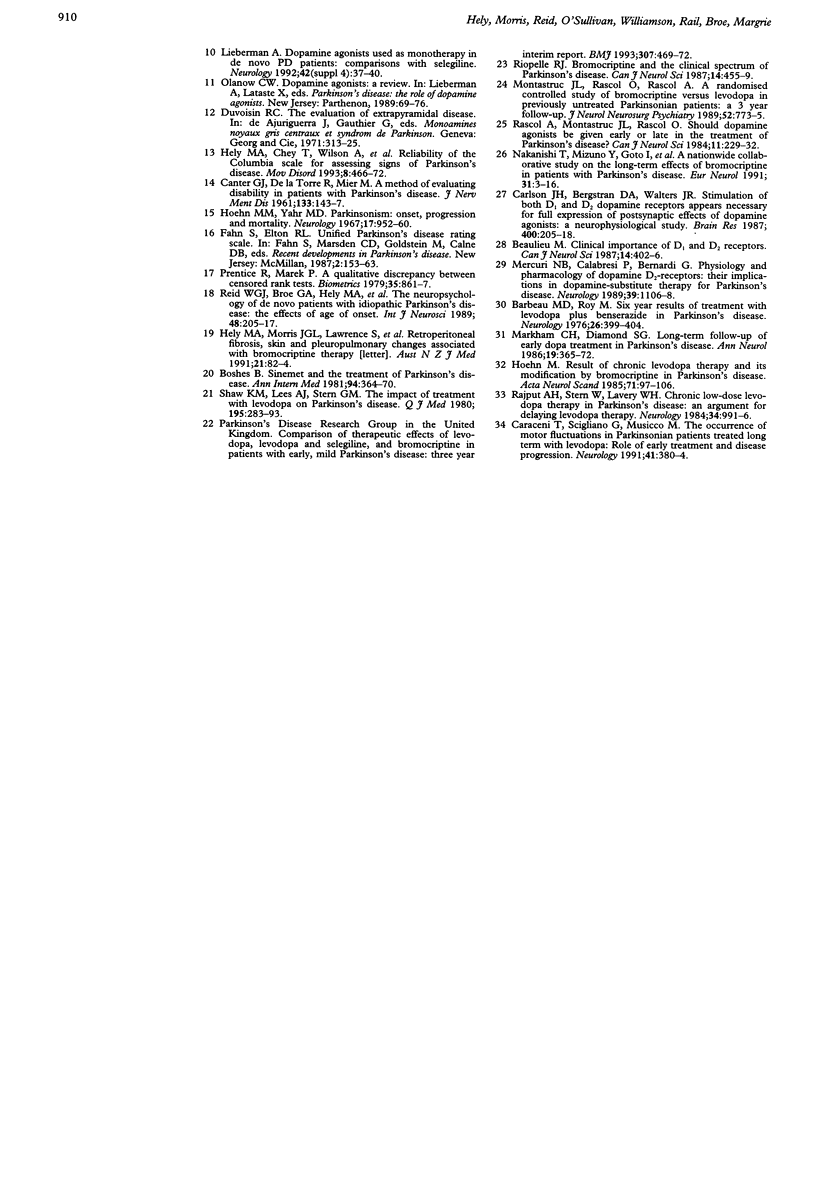
Selected References
These references are in PubMed. This may not be the complete list of references from this article.
- Aellig W. H., Nüesch E. Comparative pharmacokinetic investigations with tritium-labeled ergot alkaloids after oral and intravenous administration man. Int J Clin Pharmacol Biopharm. 1977 Mar;15(3):106–112. [PubMed] [Google Scholar]
- Barbeau A., Roy M. Six-year results of treatment with levodopa plus benzerazide in Parkinson's disease. Neurology. 1976 May;26(5):399–404. doi: 10.1212/wnl.26.5.399. [DOI] [PubMed] [Google Scholar]
- Beaulieu M. Clinical importance of D-1 and D-2 receptors. Can J Neurol Sci. 1987 Aug;14(3 Suppl):402–406. doi: 10.1017/s031716710003780x. [DOI] [PubMed] [Google Scholar]
- Bergamasco B., Benna P., Scarzella L. Long-term bromocriptine treatment of de novo patients with Parkinson's disease. A seven-year follow-up. Acta Neurol Scand. 1990 May;81(5):383–387. doi: 10.1111/j.1600-0404.1990.tb00980.x. [DOI] [PubMed] [Google Scholar]
- Boshes B. Sinemet and the treatment of Parkinsonism. Ann Intern Med. 1981 Mar;94(3):364–370. doi: 10.7326/0003-4819-94-3-364. [DOI] [PubMed] [Google Scholar]
- CANTER G. J., DE LA TORRE R., MIER M. A method for evaluating disability in patients with Parkinson's disease. J Nerv Ment Dis. 1961 Aug;133:143–147. doi: 10.1097/00005053-196108000-00010. [DOI] [PubMed] [Google Scholar]
- Calne D. B., Teychenne P. F., Claveria L. E., Eastman R., Greenacre J. K., Petrie A. Bromocriptine in Parkinsonism. Br Med J. 1974 Nov 23;4(5942):442–444. doi: 10.1136/bmj.4.5942.442. [DOI] [PMC free article] [PubMed] [Google Scholar]
- Caraceni T., Scigliano G., Musicco M. The occurrence of motor fluctuations in parkinsonian patients treated long term with levodopa: role of early treatment and disease progression. Neurology. 1991 Mar;41(3):380–384. doi: 10.1212/wnl.41.3.380. [DOI] [PubMed] [Google Scholar]
- Carlson J. H., Bergstrom D. A., Walters J. R. Stimulation of both D1 and D2 dopamine receptors appears necessary for full expression of postsynaptic effects of dopamine agonists: a neurophysiological study. Brain Res. 1987 Jan 6;400(2):205–218. doi: 10.1016/0006-8993(87)90619-6. [DOI] [PubMed] [Google Scholar]
- Hely M. A., Chey T., Wilson A., Williamson P. M., O'Sullivan D. J., Rail D., Morris J. G. Reliability of the Columbia scale for assessing signs of Parkinson's disease. Mov Disord. 1993 Oct;8(4):466–472. doi: 10.1002/mds.870080409. [DOI] [PubMed] [Google Scholar]
- Hely M. A., Morris J. G., Rail D., Reid W. G., O'Sullivan D. J., Williamson P. M., Genge S., Broe G. A. The Sydney Multicentre Study of Parkinson's disease: a report on the first 3 years. J Neurol Neurosurg Psychiatry. 1989 Mar;52(3):324–328. doi: 10.1136/jnnp.52.3.324. [DOI] [PMC free article] [PubMed] [Google Scholar]
- Hoehn M. M. Result of chronic levodopa therapy and its modification by bromocriptine in Parkinson's disease. Acta Neurol Scand. 1985 Feb;71(2):97–106. doi: 10.1111/j.1600-0404.1985.tb03173.x. [DOI] [PubMed] [Google Scholar]
- Hofmann W. W., Angel R. W. Transient responses of the normal and diseased motor system to sudden load changes. Neurology. 1967 Oct;17(10):952–960. doi: 10.1212/wnl.17.10.952. [DOI] [PubMed] [Google Scholar]
- Lieberman A. Dopamine agonists used as monotherapy in de novo PD patients: comparisons with selegiline. Neurology. 1992 Apr;42(4 Suppl 4):37–48. [PubMed] [Google Scholar]
- Markham C. H., Diamond S. G. Long-term follow-up of early dopa treatment in Parkinson's disease. Ann Neurol. 1986 Apr;19(4):365–372. doi: 10.1002/ana.410190410. [DOI] [PubMed] [Google Scholar]
- Mercuri N. B., Calabresi P., Bernardi G. Physiology and pharmacology of dopamine D2-receptors: their implications in dopamine-substitute therapy for Parkinson's disease. Neurology. 1989 Aug;39(8):1106–1108. doi: 10.1212/wnl.39.8.1106. [DOI] [PubMed] [Google Scholar]
- Montastruc J. L., Rascol O., Rascol A. A randomised controlled study of bromocriptine versus levodopa in previously untreated Parkinsonian patients: a 3 year follow-up. J Neurol Neurosurg Psychiatry. 1989 Jun;52(6):773–775. doi: 10.1136/jnnp.52.6.773. [DOI] [PMC free article] [PubMed] [Google Scholar]
- Nakanishi T., Mizuno Y., Goto I., Iwata M., Kanazawa I., Kowa H., Mannen T., Nishitani H., Ogawa N., Takahashi A. A nationwide collaborative study on the long-term effects of bromocriptine in patients with Parkinson's disease. The fourth interim report. Eur Neurol. 1991;31 (Suppl 1):3–16. doi: 10.1159/000116716. [DOI] [PubMed] [Google Scholar]
- Parkes J. D., Debono A. G., Marsden C. D. Bromocriptine in Parkinsonism: long-term treatment, dose response, and comparison with levodopa. J Neurol Neurosurg Psychiatry. 1976 Nov;39(11):1101–1108. doi: 10.1136/jnnp.39.11.1101. [DOI] [PMC free article] [PubMed] [Google Scholar]
- Prentice R. L., Marek P. A qualitative discrepancy between censored data rank tests. Biometrics. 1979 Dec;35(4):861–867. [PubMed] [Google Scholar]
- Rajput A. H., Stern W., Laverty W. H. Chronic low-dose levodopa therapy in Parkinson's disease: an argument for delaying levodopa therapy. Neurology. 1984 Aug;34(8):991–996. doi: 10.1212/wnl.34.8.991. [DOI] [PubMed] [Google Scholar]
- Reid W. G., Broe G. A., Hely M. A., Morris J. G., Williamson P. M., O'Sullivan D. J., Rail D., Genge S., Moss N. G. The neuropsychology of de novo patients with idiopathic Parkinson's disease: the effects of age of onset. Int J Neurosci. 1989 Oct;48(3-4):205–217. doi: 10.3109/00207458909002162. [DOI] [PubMed] [Google Scholar]
- Rinne U. K. Combined bromocriptine-levodopa therapy early in Parkinson's disease. Neurology. 1985 Aug;35(8):1196–1198. doi: 10.1212/wnl.35.8.1196. [DOI] [PubMed] [Google Scholar]
- Riopelle R. J. Bromocriptine and the clinical spectrum of Parkinson's disease. Can J Neurol Sci. 1987 Aug;14(3 Suppl):455–459. doi: 10.1017/s0317167100037914. [DOI] [PubMed] [Google Scholar]
- Shaw K. M., Lees A. J., Stern G. M. The impact of treatment with levodopa on Parkinson's disease. Q J Med. 1980;49(195):283–293. [PubMed] [Google Scholar]
- Stern G. M., Lees A. J. Sustained bromocriptine therapy in 50 previously untreated patients with Parkinson's disease. Adv Neurol. 1983;37:17–21. [PubMed] [Google Scholar]
- Teychenne P. F., Bergsrud D., Racy A., Elton R. L., Vern B. Bromocriptine: low-dose therapy in Parkinson disease. Neurology. 1982 Jun;32(6):577–583. doi: 10.1212/wnl.32.6.577. [DOI] [PubMed] [Google Scholar]


